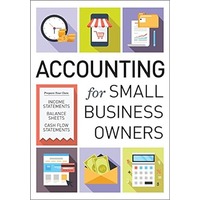Accounting for Small Business Owners by Tycho Press EPUB & PDF – eBook Details Online
- Status: Available for Free Download
- Author: Tycho Press
- Language: English
- Genre: Financial Accounting
- Format: PDF / EPUB
- Size: 5.3 MB
- Price: Free
BASIC ACCOUNTING TERMS
You will be hearing (and using) certain accounting terms,
concepts, and processes repeatedly, so you’ll want to have a
solid understanding of them. For example, you’ll need to know how
to categorize your assets, expenses, and liabilities, which will mean
creating a list of accounts. You’ll want to learn how to create
financial statements such as income statements and balance sheets,
and how to interpret them to find ways to improve your business.
These are all building blocks of accounting. But underlying all of
them is one of the most important concepts to accounting systems
and methods: the accounting equation.
THE ACCOUNTING EQUATION
The accounting equation is a fundamental principle of accounting. It
represents the relationship between three components of your
business:
ASSETS (What You Own)
LIABILITIES (What You Owe)
EQUITY (The Difference between Your Assets and Liabilities)
The accounting equation is wrien as follows:
ASSETS = LIABILITIES + EQUITY
If your books are done correctly, the two sides of this equation
will always equal each other. Accounting is a double-entry system,
meaning that for every transaction that affects one side of the
equation, there is a corresponding change (of equal amount) on the
other side.
Let’s say you bring in a printer from home for your business to
use. According to the logic of the double-entry system, two things
just happened: Your company gained a piece of equipment (thereby
increasing assets by, say, $200), and equity increased by that same
$200. In other words, the increase is accounted for on both sides of
the equation.
Accountants refer to these business transactions as debits and
credits. All our transactions are either debits or credits: For every
debit there is a credit. Debits are the le side of the equation, and
credits are the right side. Debits increase asset accounts. Credits
increase liabilities and equity accounts. We’ll go deeper into this in
A final note on the accounting equation: when we are discussing
sole proprietorships, equity is “owner’s equity.” It belongs to the
business owner. When we are looking at corporations, equity is
“stockholders’ equity.” It is shared by the stockholders.
What Is a Chart of Accounts?
A chart of accounts is simply a list of all the accounts you will be
using in your bookkeeping. Account is an accounting term used to
describe a certain classification of a transaction. Don’t think of it like
a checking account—think of it as a box. In each box, you will keep
all like transactions. For example, all sales go into a box (account),
and all office supply purchases go into a box (account).
Your
accounts will be divided into the following categories: assets,
liabilities, equity, revenue, and expenses (see Figure 1).
Your chart of accounts will determine how you record your
business transactions and is the basis of all your important financial
statements. Your accounts always tie back to the larger principle of
For More Read Download This Book
EPUB



